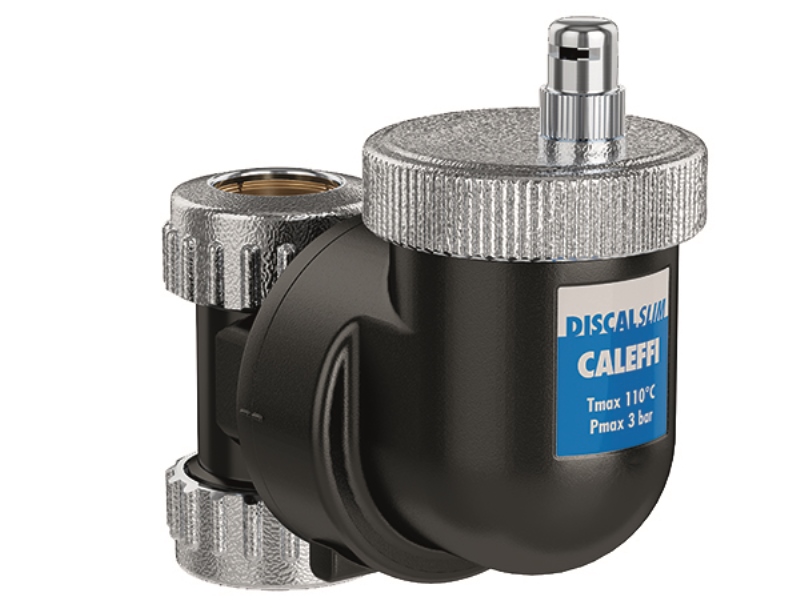
Air and dirt in hydronic systems cause operational problems and their removal is a key factor in achieving maximum efficiency. Steve Elsmore, Senior Technical Support at Altecnic, breaks down why the removal of air from systems is important and describes the components that can be installed to remove air from systems.
Q. What is deaeration?
Deaeration is the process of separating air from water and then eliminating the air from a water distribution system.
Q. Why is air present in the water?
Cold mains water used to fill systems is often more than 95% saturated with dissolved air consisting of a mixture of Oxygen-O2 (21%) and Nitrogen – N2 (78%) and other trace gases which can exist in a dissolved state integral with the water molecules. With non-dissolved air, the gases are separate from the water molecules and are entrained in the form of bubbles of various sizes down to the microscopic level.
The ability of water to retain air is proportional to pressure (according to Henry’s Law) and inversely proportional to temperature. When the temperature or pressure of water is changed such that the solubility is reduced, dissolved air will be released from the water in the form of bubbles.
There are three forms of entrapped air:
– Stationary air pockets at high points
– Entrained micro-bubbles
– Dissolved within water
Q. What problems arise from air in water?
Nitrogen is the main cause of classic air problems whereas oxygen is the main cause of corrosion. Air management is an important factor in any closed loop hydronic system. If neglected, the presence of air can lead to many unexpected consequences; premature deterioration of equipment and decrease in overall system efficiency. Free gas bubbles may significantly affect the circulation. As bubbles pass along a water distribution system, they can coalesce (bind together) in areas of low velocity to create localised air pockets which remain in place and reduce flow rate.
Control of dissolved oxygen is a key aspect of controlling corrosion and to manage the corrosion risk, the oxygen concentration should ideally be reduced as quickly as possible after commissioning. Oxygen is a highly reactive gas and if air is constantly present in a system because of inadequate deaeration, continuous exposure would accelerate corrosion of ferrous materials, affecting steel piping, cast iron boilers, expansion tanks, eventually leading to reduced performance and leaks.
The mixture of air in water is acoustically active. Flow noise in pipes, fittings and radiators is quite irritating for building occupants and is a sign of the presence of air in the system.
Q. Why is deaeration important?
A new hydronic system begins life completely filled with air and the main objective is minimising the amount of air present during filling and then eliminating the remainder. Traditionally, systems are filled from the bottom up to allow air to be expelled by air vents. Hydronic balancing and control valves require deaerated water to achieve designed flow characteristics. Presence of air in the system could change the Kv of balancing valves and their water flow characteristics. Air would also cause excess turbulence and unstable pressure signals downstream of a valve.
Commissioning should not be attempted without prior elimination of air from a system. Unlike water, air is a good insulator. If air is present in heat transfer devices such as coils, radiators and heat exchangers for example, it significantly reduces the rate of heat transfer and overall efficiency. Air trapped in a hydronic heating system can reduce energy efficiency by up to 10% and contribute to corrosion which in turn can result in blockages in pipes and equipment.
Maintenance work on systems, fresh makeup water and porous joints and non-metallic tube are examples of how air can be repeatedly introduced into a system after it is put into service.
Q. How does deaeration work?
Automatic Air Vents are designed to continuously remove air without manual intervention which accumulates in hot and cold-water distribution systems. Placed at high points in a water distribution system Automatic Air Vents will ensure efficient initial venting of accumulated air to atmosphere during filling because the water is not flowing. Air vents will not capture bubbles from flowing water.
After initial venting, the system water will still contain micro-bubbles and dissolved gases. Gas bubbles and micro bubbles are carried along with the flow therefore separation is only possible with specific devices. Micro bubbles are extremely small and occur in large numbers and have a tendency to stick to surfaces making the separation process more difficult. With dissolved gases, the gas molecules are bonded between the water molecules in such a manner that they can only be removed by means of pressure reduction or temperature increase. Due to the pressure and temperature differences in a system, dissolved gases can desorb into bubbles.
Q. Which products are used for deaeration?
Air separation is achieved using specific products at various locations. As described above, Automatic Air Vents will provide system venting during initial filling of the system (and draining where necessary).
Air vents are not intended for operational venting when directly installed on flowing pipes. They are designed such that accumulated gases are vented off but they are not able to separate bubbles from flowing water.
The design of separators causes the flow velocity to be locally reduced within the main body allowing existing bubbles in the less turbulent water to rise to the top and the gases are expelled through an integral, top mounted Automatic Air Vent.
Separators for micro-bubbles are compact units and are suitable for operational de-gassing and continuous venting. An internal mesh type of baffle with sharp edges induces the micro-bubbles to cling to the surface which then coalesce into larger bubbles which rise and are expelled to atmosphere.
Manual Air Vents are often sufficient to eliminate air pockets in heat emitters such as radiators.












